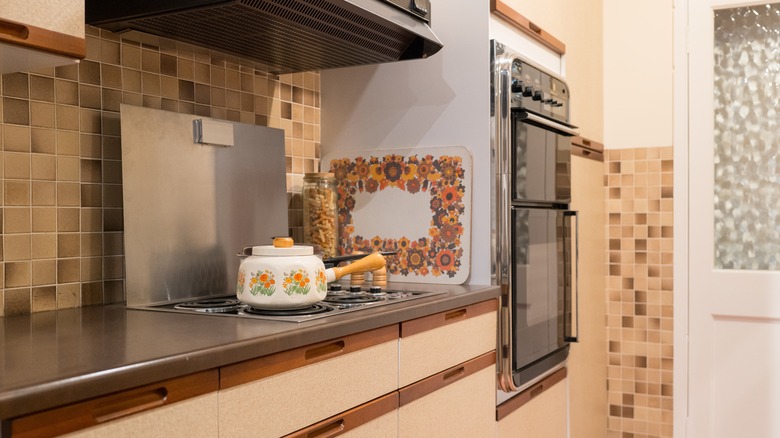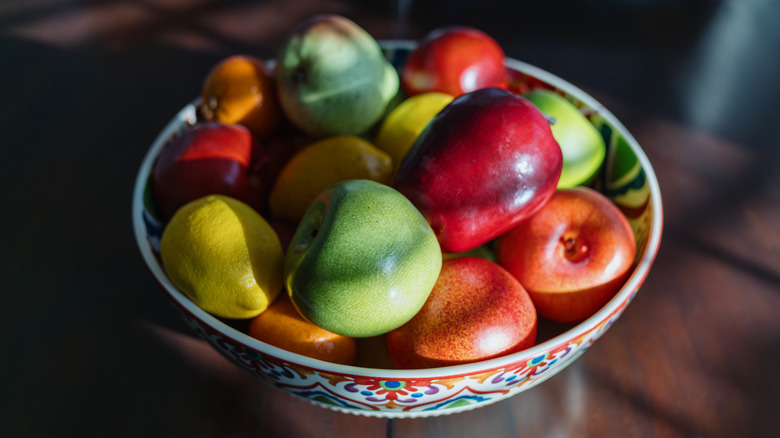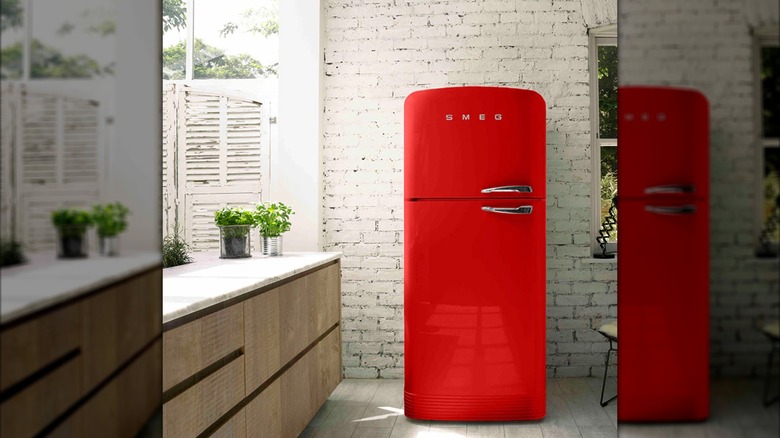5 Vintage Kitchen Decor Trends From The 1970s That Are Coming Back Around
Design trends are highly cyclical. Themes and motifs that first became popular decades ago fall into disfavor and eventually regain their popularity, often with tweaks on the original designs. This is true of most things, from clothing to kitchen decor. One example is the comeback of 1950s-era sink skirts. However, a different decade's decor is having a more notable resurgence.
The 1970s were known for big pops of color and groovy design work, and several of the decade's trends are coming back to modern kitchen decor. Walls can be stylishly adorned with interestingly patterned wallpaper and decorative tilework — which can either resemble the gaudy fruit tiles of old or feature more contemporary designs. On tables and countertops, the vintage styling of decorative fruit is coming back to evoke feelings of freshness. This is complemented by two other resurgent '70s trends, colorful appliances and bright colors in general, especially in cabinetry.
Wallpaper
Kitchens in the 1970s were often covered with wallpaper featuring complicated designs like floral patterns or swirls of color that can perhaps most accurately be called "groovy" design. Wallpaper isn't just making a comeback in the modern kitchen but also in the entire home. Vintage wallpaper is particularly prized by homeowners who want to directly recycle '70s-era design trends to add a distinctive retro pop to any room, especially kitchens. Vintage '70s wallpapers are often loud and unmistakable, making them great for accent walls.
Modern wallpapers that reflect '70s design trends might be more muted, using earthy, retro tones and subtle designs to create a sense of calmness. They may also go the other way and lean heavily on distinctive patterning, particularly flowers and other flora. Wallpaper is also one of the most affordable kitchen backsplash ideas out there, especially since some modern options can be much easier to clean.
Decorative fruit
Decorative fruit may be a '70s decor trend, but true to the cyclical nature of design, the concept is actually centuries old, dating at least as far back as Renaissance Europe. One of the many ways royal families asserted their wealth to guests was elaborate, custom table centerpieces, usually made of wax, sugar, or marzipan. Among the popular themes for these were artificial fruit.
Today, as in the 1970s, decorative fruit is not typically made with edible foodstuffs, which can decay and attract flies over time. Instead, artificial fruits are commonly made of mass-produced plastic, delicately blown art glass, or carefully carved and polished stones.
Decorative fruits are enjoying a comeback from their recent '70s roots for the same reason that fruits and vegetables are always at the front of a grocery store: a produce display suggests both freshness and deliciousness. It's welcoming and appetizing, perfect for a kitchen vibe — except artificial fruits won't spoil and ultimately waste your money.
Decorative tile work
Fans of home renovation shows are probably familiar with the decorative kitchen tiles of the '70s, often featuring large, realistic prints of fruits, flowers, or vegetables. While some people may still consider these gaudy and grandma-like, decorative tilework in general is certainly coming back — sometimes including those same vintage patterns.
Like vintage wallpaper, vintage kitchen tiles are commonly available for sale online and can be used in a more modern sense to create an accent wall rather than blanketing the kitchen. Modern decorative tiles, often in more muted colors like gray, brown, and green, are commonly centered in one part of the room to serve as a focal point.
Whatever the case, one important thing to remember with kitchen tile work is that you should never put white grout in between the tiles. Kitchens can be messy places at times, and not only will white grout show the stains more prominently than any other color, it's also notoriously difficult to fully remove stains from, especially persistent ones like tomato sauce. Gray or black grout hides long term stains better, but peel-and-stick tile is superior in this regard, requiring no grout at all.
Colorful appliances
One of the most striking parts of 1970s kitchens was the colorful appliances. When they weren't decked out in wood accents, kitchen appliances often had stark, unusual colors popular to the era such as avocado green and mustard yellow. Like other '70s decor trends, these gave way to newer fads like white, black, or stainless steel appliances.
Stainless steel arguably has a timeless appeal because it's easy to clean, but white and black appliances (especially white) are giving way to their colorful predecessors. Modern kitchens use colorful appliances for vivid splashes of color in otherwise dull spaces where larger appliances can function similarly to an accent wall.
In this sense, they fill a similar decor niche as the perennially popular Kitchen Aid mixer or Le Creuset cookware, prized as much for their quality as their range of colors, which can add infinite personality to a kitchen. Think of the return of colorful appliances as the same basic decor principle, simply blown up to oven or refrigerator scales.
Colorful cabinetry
One theme has been common throughout all of these resurgent '70s design trends: color. Kitchens of the era were drenched in a sometimes chaotic variety of rich hues from floor to ceiling. This is especially true of cabinetry, which could feature neutral-colored frames with bright, bold colors like Ferrari red on doors and drawers.
Modern kitchen decor is loosening its grip on greige (a combination of gray and beige) and beginning to re-embrace the brighter tones of the 1970s, albeit in a more restrained way. Rather than covering the kitchen in variations of yellow, pink, or green, modern design uses restraint to show that, with color, sometimes less is more.
Stylish kitchens nowadays can take on a two-tone appearance, with one popular option being big, bright colors for lower cabinets and lighter, neutral tones for wall-mounted cabinets. The combination makes rooms seem larger and brighter, which is good on its own but also makes the limited color selection pop even more.





